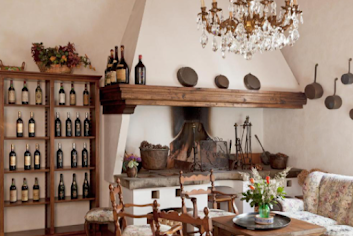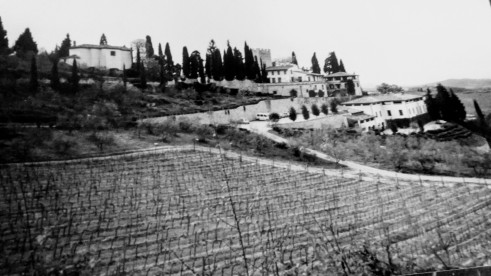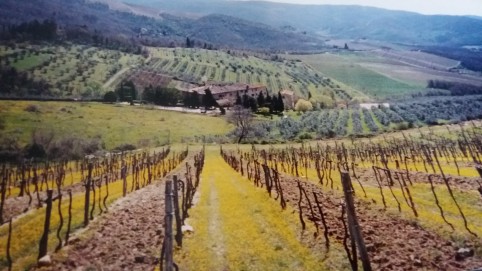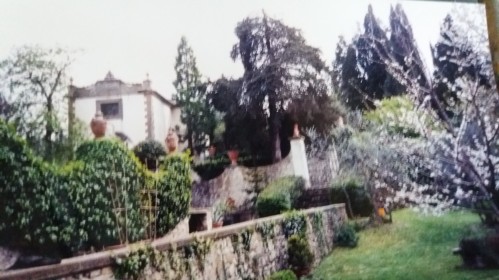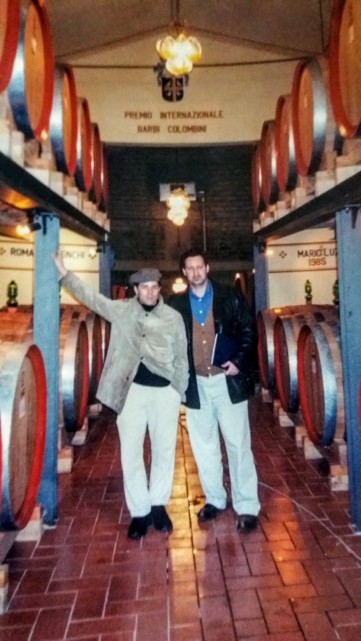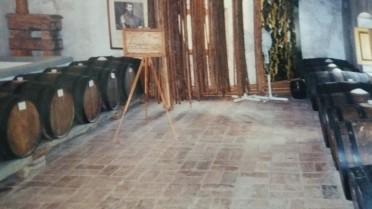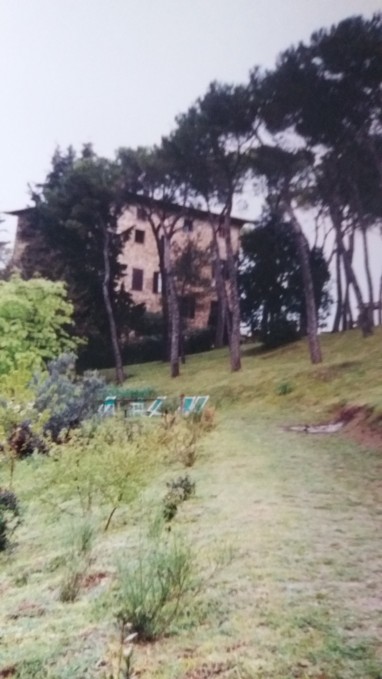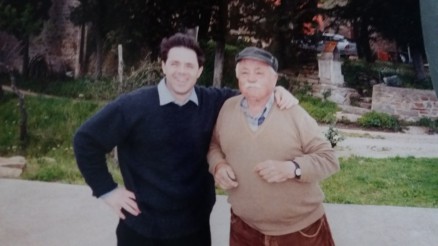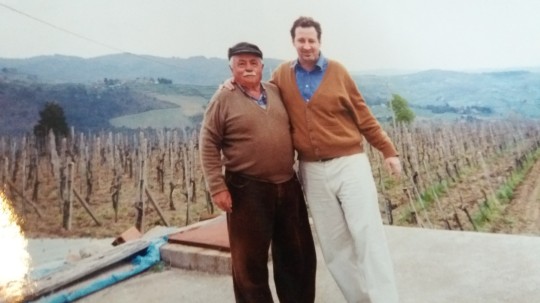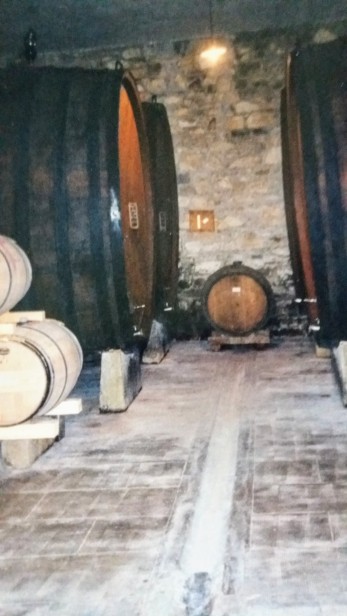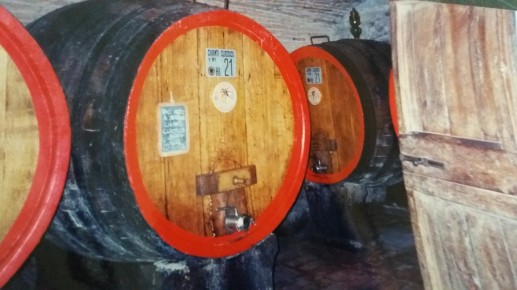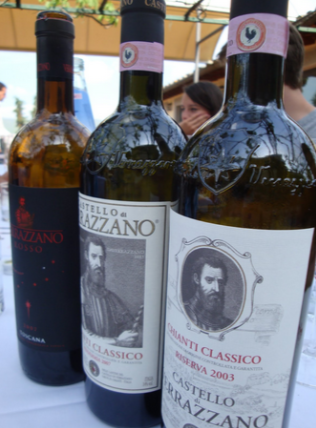CHIANTI
CASTELLO VERRAZZANO
.
.
CHIANTI
From My Friend, The CONTI CAPPONI
CHIANTI VEILLA CALCINAIA
GREVE
.
.
Vignamaggio
CHIANTI CLASSICO
The 2011 Wine Gala Wine Tasting held by the Italian Trade Commission was not as fat as years past. In these lean economic times, what really is these days? Macs, iPads, iPhones, and all things Apple? What else.
Yes things were lean but there were a few bright spots to be sure. Let me start with the wines of the uber popular estate of “Ruffino” and its most popular wines Chianti Riserva Ducale and its prestigious Ruffino Chianti Classico Riserva “ORO,” Gold Label. To the most serious and knowledgeable of Italian Wine Aficionados these wine are normally dismissed as commercial and passe, but to many Italian-Americans and older slightly moneyed New York Italian-Americans and “Guys with Bent Noses,” and guys who like to emulate Guys with Bent Noses, Ruffino Ducale Gold Label is held in quite high esteem. This wine has a history and presence in New York when it was one of more or less a handful of Italian Wines in this country compared to the thousands available today. Back in the 60’s and 70’s Ruffino along with the wines of Bertani, Masi, and Pio Cesare were thee top of the line, and people dining at the many Old-School Italian Restaurants of the day gravitated to these wines like Flies on you know what.
Anyway, many more wines became available, more people visited Italy and explored the wines, many more wines became available and to many, the so-called “Old School” wines like Ruffino and Pio Cesare lost some of their luster. That being said, there is still a quite considerable number of people, especially men over the age of 50 (Italian New Yorker’s) who still hold this wine in high esteem, and order them often in the Italian Restaurants, in New Yor and elsewhere.
OK, so let’s talk about the wine tasted this day. As usual the Ruffino Ducale Oro Gold Label 2005 disappointed. The wine which is a Premium Wine at a “Premium Price” quite often disappoints, as it did on this day. It just was not well balanced, it lacked fruit, and just was not enjoyable to put it in the simplest terms possible. The much cheaper wine from this estate (Ruffino), the Ruffino Ducale Chianti Riserva 2006 (Tan Label) on the other hand was quite enjoyable and a “Superior Wine” to the Ducale “Oro” (Gold Label) 2005. A wine that cost substanially more. The Ruffino Tan Label Chianti Riserva was well rounded with proper tannic and acidic components, with a generous amount of Fruit and weight that was just right, not too much nor too little. It was a pleasant wine to drink. And for those of the general public who don’t normally know a great deal about wine as far as all the intricacies are concerned (which can be just a bunch of BS), but they know when they like and totally enjoy a wine, you should know that quite often the lesser simpler wine’s of any particular estate are better, tastier, more enjoyable than the supposedly “Better” more costly Premium wines, which is the case once again with the current vintages available from the estate of Ruffino. The cheaper wine, the Chianti Riserva (Tan Label) is far superior than the estates more expensive premium wine, the Ruffino Chianti Classic Gold Label. OK, enough on this. Let’s move on.
At this Gala Tasting, the fine wines of Franco and Son Jacopo Biondi Santi were on hand from their two Tuscan estates Castello Di Montepo and their famed Brunello estate Tenuta Il Greppo where Franco and Jacopo’s forefather “Created” Brunello.
First I tried the whole line of Super Tuscans and Morellino Di Scansano from the Montepo Estate. A wine that is one of my all-time favorite Super Tuscans, “Sassoalloro” was a bit of a disappointment this time around with the 2007 vintage. I have loved this wine over the years especially the 1993 Vintage which I drank with Jacopo Biondi Santi and 14 other noted New York Italian Wine Guys, which included; Renzo Rapiscoli, Charles Sciccialone at a wonderful Wine Tasting Dinner Jacopo hosted at Spark’s Steak House back in 1998. The wines that evening where outstanding, including; the Sassoalloro, Schidione, Moscadello, and several vintages (1988, 90, and 93) of Biondi Santi’s “Famed” Brunello.
So, back to the wines on this day. The Schidione was quite nice, the Morrellino good. The two Brunello’s on hand for the day were showing nicely but will be at their optimum in a few years, as these wines are made to age, drinking best with 15 to 20 years or more on them. The Brunello’s this day were the 2005 Normale and the 2004 Riserva, both excellent and showing great promise down the road. Bravo Jacopo.
Now down to the stars of the show and the wines of Castello Di Querceto in Greve in Chianti.
I met with Dottt. Alessandro Francois and Maria Antonietta Corsi of Castello Querceto and they tasted me on their wines, of which 3 of the 6 I tasted were absolutely outstanding. The base Chianti in the Querceto Chianti Classico 2008 was a enjoyable textbook Chianti, medium bodied, good Cherry fruit flavors, with a bit of zippy acid and just perfectly balance. Next up was the Chianti Classico Riserva “Il Picchio” 2007. A beautiful wine that had all the great characteristics of the previous Chianti with just a notch upward of fruit and weight. I loved the Super Tuscan offering in the Querceto “Il Quercioaia” 2005. The wine had great balance, it was full in flavor with beautiful Cherry and Black Fruit flavors. made of 65% Sangiovese and 35% Cabernet Sauvignon, this wine was a joy to drink.
Let me note that all the Chianti’s of Castello Querceto are “Real Chianti” and not aborted sacrilegious so-called Chianti that contain Merlot and Cabernet Sauvignon in the blend, which are allowed by the government because of political reasons in Chianti which is a “Complete and Total Sacrilege” which any true Chianti aficionado will tell you that, Merlot, Cabernet Sauvignon, Shyrah or any none native grape should “Never Ever be Allowed” in bottle of wine labeled Chianti. Chianti is a great wine made primarily of Sangiovese with small quantities of other minor native grapes such as; Colorino, Malvasia Nero, Cielliegiollo, and Canaiolo.
All the Chianti of Castello Di Querceto are real Chianti in that they are all made with only native grapes which include about 95% Sangiovese and 5% Canaiolo. “Thank you Castello Querceto,” and all other Chianti producers like Monsanto, Castello Verrazzano and others who make “Real Authentic Chianti,” Chianti that contains only “Native Grape Varietals” and no trace of International Grapes such as Merlot or Cabernet Sauvignon.
“STOP The SACRILEGE !”
Stop letting non-native Chianti Grape Varieties in CHIANTI !”
“PLEASE” !!!
Make REAL CHIANTI !
“MAKE CHIANTI GREAT AGAIN” !!!
Note : Making this note, on Tuesday September 28, 2021, some 12 years or so after I wrote the above article. I am a big fan of Chianti, as you may have gathered. I love it, and have been drinking Chianti for some 40 plus years now. I’m a purest and traditionalist, and love the Chianti of older days, and current ones as well, that are made according to the old tradition, Chianti that is made of only native Chianti grapes, of primarily of Sangiovese, with small amounts of native blending grapes like: Canaiolo, Colorino, Malvasia Nero, and Ciliegiolo, with absolutely no Internaltiona Grape Varietals such as Merlot or Cabernet Sauvignon. My words may sound harsh, but I am a passionate person, and hate to see Chianti being ruined. And especially for no reason at all. There is no need to put Merlot or Cabernet Sauvignon into Chianti, when the perfectly suited native blending grapes I’ve just mentioned are available.
I say to producers in Chianti, “If you have international variety grapes on your estate in Chianti Classico and want to make wine with them, then by all means, do so. Just don’t call it Chianti. Use your Merlot, and or Cabernet to make a rosso or Super Tyscan bottlings, and make your Chianti with of course primarily Sangiovese and small amounts of either Canaiolo, Malvasia, Colorino, and Ciliegiolo. Please!”
Also to the Goverment of Italy and Italian Wine laws. Please change the horrible ammendment you made in 1994 that allows Chianti to be made with international non-native Chainti grapes into Chainti Wine. You should only allow native grapes of the region, and ban Merlot and Cabernet from the make-up of Chianti Classico wine right now and forever. Also, change the rules back to making Chianti as a blend of grapes, with 92% Sangiovese and 8% of native grapes, such as: Colorino, Malvasia Nero, Canaiolo, and Ciliegiolo grapes. Make Chianti, Chianti again! Please!
I ask, why do you want to make wines like everyone else in the World when you have your own wonderful wine that is inique to the World, and should always be made so, in the old original tradition of making Chianti, again mostly with the native Sangiovese making up more than 90% of the blend. And blend being a very key word. Chianti has always (until the insane law change in 1994) been a blended wine, made moslty with Sangiovese ( over 90%), but always including a small percentage of the regions other native grapes, usually Canaiolo or Colorino, as well as Malvasia Nero and / or Ciliegiolo grapes, and never ever any grapes like Merlot, Cabernet or Syrah that are not native to the region. “Why do that?” It just doesn’t make sense to destroy your wonderful native wine of Chainti that is (or was) unique to the World.
Basta !
The governing body that makes the wine laws in Italy is the Camitao Nazionale del Vino (National Wine Committee).
Daniel Bellino Zwicke … September 28, 2021
.
with his friend Cavaliere Luigi Cappelini
Of CASTELLO VERRAZZANO
Greve in Chianti
ITALY
SUNDAY SAUCE
RECIPES for CHIANTI
CHIANTI FIASCI
The BARONE RICASOLI
In NEW YORK
And his CHIANTI
Sebastiano Capponi (L) with Daniel Bellino Zwicke
and Joe Macari (far right)
Chianti Classico Tasting
On Monday , April 21st 2008 the greatly anticipated Chianti Classic Tasting was held at 583 Park Avenue. Hosted by the Consorzio Vino Chianti Classico, which is a Consortium of Professionals who are made up of Wine Producers (Proprietors and Winemakers) of the wine Chianti Classico. This group is not a Governmental Body but a private group of individuals that was created in 1924 to define the area of Chianti Classico and its wines, also called Chianti Classico and the manner and guidelines of how the wine was to be made and the parameters of what constitutes a Chianti Classico. Yes the name of the zone and the wine are the same, “Chianti Classico,’and the wine was actually name after the zone.
When the Consorzio Vino Chianti Classico was created in 1924, there did not exist any governmental bodies that now do to set guidelines and laws to which wines have to adhere to all over Italy.This is why the consorzio was created in the first place, in order to define which area was the “Classico” area and to maintain quality and consistency.
This Grand tasting held in New York on April 21, 2008 by the Chianti Consorzio was personally hosted by the President of the Consorzio, Marco Pallanti who is also the Enologist and proprietor along with Lorenza of the renowned estate of the
Castelo Di Ama in Gaiole in Chianti.
As for myself, if feel that the wines of
Castelo Di Ama are overrated, grossly overpriced, and not worth the money. I actually have personally monikered the Castelo di Ama Estate the “Gaja of Chianti” of Angelo Gaja and his wines, which are highly overrated and even more grossly overpriced as well. But this however is for another discussion.
Along with Dr. Pallanti the event was also hosted by esteemed Sommelier and wine writer David Lynch, who co-authored one of the Italian Wine Worlds most renowned books on the subject of Italian Wine, Vino Italiano along with Joseph Bastianich.
The tasting was made up of 40 producers of Chianti Classico of which there were over 150 different Chianti offered for tasting. The Chianti presented were both
Chianti Normale (base Chianti) and Chianti Riserva and the vintages ranged from 2001 to 2006.
Note that “Chianti Normale” or base Chianti does not infer that these Chianti are of a lesser quality. The styles are different and the base Chianti are to me and many others, actually more the true and traditional of Chianti as the weight is lighter more correct and less concentrated than the weight (body) of Chianti Reserva.
As with many subjects there is debate and differences of and agreement of what is true traditional Chianti is and what is not. I as a Wine Professional of many years who has focused mainly on Italian Wine and a great lover of Chianti and a traditionalist at heart, of course I am of the Old-School Traditional Chianti. I do feel that the laws of the Chianti Consorzio are not correct and are not for the Great Tradition of Chianti in that the wine Chianti when created by the Baron Ricasoli almost 150 years ago was created as a wine made up as a blend of local grapes that was dominated by Sangiovese as its main grape and that Sangiovese was to be the primary grape of Chianti and to give it its special character along with small percentages of other local blending grapes such as Cannaiolo, Colorino, Trebbiano, Ceiligiolo, Malvasia Nera, and Mammolo.
I feel, as do other respected authorities on Italian Wine, such as one of my esteemed peers Charles Scicilnoe feel that the Italian Government and Chianti Consorzio are by allowing Cabernet, Merlot, and Syhrah into Chianti, are ruining this “Great Wine” Chianti and its great traditions.
Just a small percentage of Cabernet Sauvignon or Merlot in what is allowed to be Chianti, completely changes the feel and taste of Chianti and what, according to tradition it should be.
“It’s not Chianti anymore!” Not it if has the slightest trace of Cabernet or Merlot, and traditionalist like myself, Charles Scicilone and others will not cease our Crusade until the day that the Italian Government and Chianti Consorzio come to their sense and completely eliminate Cabernet Sauvignon, Syrah, Merlot, or any non-native grape variety from ever entering Chianti again.” We wait patiently, but why is it taking these people so long to act. They ruin one of their own National Treasures and every year that these grapes that are not of Chianti Classico, is another bad vintage for any producer that uses them.
Let’s note that although the sacrilege of allowing Cabernet, Merlot, and others into Chianti, it is not mandatory and is at each individual producers (Wine Estate) choice whether to put these grapes in their wine or to leave them out and thus make “Real,”
True, Traditional Chianti. There are a number of Estates that make real true Chianti devoid of any trace what so ever, of the dreaded Cabernet or Merlot. Some of these estate are; Castello Volpaia, Castello Verrazzano, Monsanto, Castello Querceto, and
Castel Vicchiomaggio to name a few. These estates are to be highly commended and there should be more. If all the producers in Chianti had enough pride, non would ever permit a bottle of wine that they label be called Chianti if it has Cabernet, Syrah, Merlot or any non-native grapes in it. Hey if you have acres of Cabernet or Merlot planted on your estate and want to use them, “Fine.” Just don’t call the wine Chianti! Classify it as IGT and call it “Super Tuscan,” it’s OK by me, “Just don’t call it Chianti!”
If you want to make a wine and call it Chianti, make sure it is a blend. A wine that is made of 100% Sangiovese is allowed to be called Chianti, though it should not. As per the original Chianti Recipe, Chianti is always a blend, made primarily of Sangiovese with other native grape varieties such as; Mammolo, Cannaiolo, Malvasia Nera, Trebbiano, and Colorino and Chinati should always be made with mostly Sangiovese with other minor blending grapes. It should never be made solely of Sangiovese (though according to the Government it can, but what does the Gov’t. know?) but have at least one or more other native grapes, even if it’s just 2 or 3%, there “Must” be at least one other native grape varietal accompanying the Sangiovese, it should not stand alone. This must be changed in order to make true Traditional Chianti.Daniel Bellino Zwicke April 2008Some of our Favorites of the Chianti
Tasting 2008: CHIANTI CLASSICO, VILLA CALCINAIA 2004 from Conti Capponi in Greve
CHIANT CLASSICO, CASTELLO BROLIO 2001 from the Barone Ricasole GaioleCHIANTI CLASSICO RIS. ROCCA GUICCIARDO, CASTELLO BROLIO 2005CHIANTI CLASSICO, FONTERUTOLI 2005 from Marchesi Mazzei, Castellina
Sebastiano Rosa with Daniel Bellino Zwicke
and Giovanni Folnari
At a TRE BICCHIERI TASTING in NEW YORK
The three friends drank Chianti, Brunello,
and Sassicaia (Super Tuscan Wine)
at The Tre Bicchieri Italian Wine Tasting, by Slow Foods
in New York. Sebastiano Rosa was the former winemaker
of Sassicaia at his family’s wine estate Tenuta San Guido,
Bolgheri, Italy. Sebastiano now works with Agri Punica
in Sardenia, Italy, making Barua and Montessu.
Giovanno Folnari is one of the owners of Nozzole in Greve, Italy,
and hsi family makes Nozzole Chianti Classico and the Super Tuscan Wine
“IL Pareto” (100% Cabernet Sauvignon) at their estate Tenuta Nozzole in Greve.
The Folnari family also makes Brunello La Fuga in Montalcino.
Daniel Bellino Zwicke is a Best Selling Author of Italian Cookbooks, Trave and Wine Guides, the creator of Bar Cichetti, America’s 1st ever Venetian Wine Bar (Bacaro), and was the former WIne Director of Barbetta Ristorante in
New York, running the wine program of what has been considered the greatest
Italian Wine Cellar in the United States at Barbetta.

Author Daniel Bellino Zwicke
with The MARCHESE PIERO ANTINORI
At a ANTINORI TASTING in NEW YORK
POSITANO The AMALFI COASTCOOKBOOK / TRAVEL GUIDE
Harvesting SANGIOVESE
GOING to ITALY ?
FLIGHTS & HOTELS
WORLDWIDE
My 1st Big CHIANTI EXPERIENCE
VILLA CALCINAIA
CONTI CAPPONI
LUNCH with The CONTI CAPPONI
April 1997
GREVE, ITALY
ITALIAN COOKBOOKS












